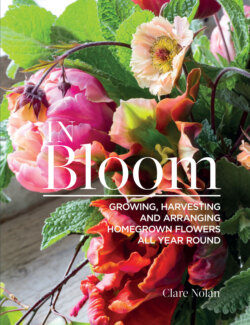Читать книгу In Bloom - Clare Nolan - Страница 17
На сайте Литреса книга снята с продажи.
THE SMALL CUTTING PATCH
ОглавлениеA bed measuring 47 in (120cm) deep x 94 in (240cm) wide will provide you with blooms from spring to autumn if succession planted. I’ve chosen 47 in (120cm) as the depth of the bed so that you can easily reach across without standing on the soil. Also, the plant spacing I use most regularly for annuals divides easily into 47 in (120cm). Just make the bed longer if you have more room. If possible run the bed from east to west and plant the rows from north to south so that you aren’t shading shorter plants with the taller ones.
I’ve drawn this cutting patch as one bed, but you could separate out these “ingredients” and put them in various parts of your existing garden or divide them up and grow them alongside your veggies – they could even be grown in large pots.
In a small plot like this one, it doesn’t make sense to grow trees or shrubs – you’ll get better return on your space by planting hardworking annuals and bulbs.
To get the most flowers from your bed, you need to plant annuals closely together in blocks and rows – ignore what the seed packet says and work to the spacings on page 39.
Tag-team flowers so that the same growing space is used all the way through the cutting season – replacing one spent row or block of plants with a batch of new ones. Tulips treated as annuals and pulled up after flowering can be replaced with HAs or HHAs. Once biennials have gone over, they can be replaced with HHAs.
If you have space, grow seedlings in pots and rainwater gutters elsewhere so that you can get a head start and replace spent plants with jumbo seedlings that are closer to flowering.
In your permanent planting areas, choose plants that make the perfect bedfellows, sharing the same soil and following on from one another. If your winters aren’t too extreme, dahlias should overwinter okay with a thick mulch and work well planted over narcissi bulbs. Plant the narcissi bulbs deep during the autumn and then plant the dahlia tubers over the top (in autumn if you can get hold of them or in late spring if not).
When choosing which annuals to grow think about your mix of foliage, fillers, and flowers so you get the balance right. You roughly want a 50/50 split of flowers vs. foliage and fillers. Consider their planting heights when planting out so that short plants won’t be shaded by taller ones.
Sweet peas will flower for about two months well; be brutal and once productivity decreases, pull them out and follow on with HA flowers, fillers, and foliage – either direct sown or as seedlings grown elsewhere. You could always follow on with a HHA climber that you’ve been growing in pots elsewhere – like Cobea.
